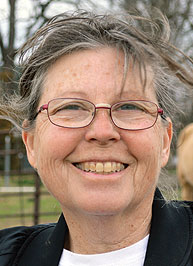
Michael Hackbart’s flock of Royal White sheep are idea for his Miklin Creek Farm
Living the Dream may have become a pop song, television show and catch phrase for many in recent year, but it is pretty close to reality for Michael and Linda Hackbart of western Laclede County, Mo., as they raise Royal White sheep on 115 acres.
A retired computer software engineer from oilfield services in the Houston, Texas, area, Michael and his wife bought their farm and used it as a vacation destination, as did their family members, including their daughters Katie, Lauren and Beckah, and son Matt, and their families.
Matt, his wife, Emily and their children livre with Michael and Linda at the farm.
“About 30 of our acres are in pasture and the rest is wooded,” Michael explained. “Our son had a farm in Oregon and brought us some Jacob sheep lambs when they moved here, but I found them to be pretty skittish and the ram was really destructive. We also had a few pigs at first but that didn’t really work out. Then we found the Royal Whites and now we have 15 ewes and at the moment, 22 lambs.”
Royal White sheep are a relatively new breed, established just 20 years or so ago by the late William Hoag of Hermleigh, Texas. A hair sheep, Royal Whites are bred to produce more meat than Katahdin or Dorper breeds, but with less fat. They are characterized as the first new breed of sheep in the United States in more than 25 years.
“As a hair sheep, they require a lot less maintenance, since there is no shearing,” Michael explained of his registered flock. “They are also naturally parasite resistant so that really helps. We wait in the morning until the dew is mostly off the high grass before turning them out of their pen and that also helps keep the parasite problem under control as the worm larvae go back into the ground as the grass dries.”
Michael hays 13 acres of his Miklin Creek Farm, and that has provided an ample amount of hay for his sheep, as well as leaving him enough to sell. He also rents out a portion of his pasture to a neighbor for cattle grazing.
The Royal White breed is proving to be very hardy and requires little maintenance.
“We use alfalfa pellets as a supplement, but they are almost like a treat,” Micheal explained. “We feed hay during the winter months but we mostly pasture our sheep so our feed costs are minimal. We vaccinate with CDT (Clostridium perfringens type C and D and tetanus), keep antibiotics on hand, and use lamb booster to get them started but other than that and hoof trimming, there is very little management involved. Our fields are soft, muddy ground so our sheeps’ hooves don’t get worn down like they would on rocky ground.”
Micheal retains some of his ewe lambs for his herd, but most of his ewes go into production at other farms.
“I’ll probably keep five to seven of this year’s ewes, maybe even a couple more,” he added with a laugh. “I’m not selling much commercial right now, just selling to other breeders to help them build up their own flocks. I’ve had them come from Kansas, Oklahoma, Arkansas, and Illinois.
The high materanl traits of the breed are another factor the Hackbarts apprciate.
“The Royal Whites are very docile and excellent mothers. I have one ewe that had triplets last year and she raised them all by herself. In another example, I count sheep every night so when one was missing, I had to go looking for her,” he added. “I found her in the far pasture, refusing to leave her newborn. I managed to get the lamb into a sling, which I held outside the four-wheeler door as I drove slowly and she followed right along back to the sheep pen.”
Micheal gives speical attention to his flock’s breeding program, traveling to Kentucky recently for his new ram.
“I am very careful to maintain a low coefficient of inbreeding (COI) in my flock so as not to magnify any genetic defects.” he explained.
While the Laclede County, Mo., property started off as a vacation tretreat, Micheal is glad to call the Ozarks home.
“We have family in Texas and Wisconsin, so we were looking for someplace in the middle and we found it right here in Missouri,” Micheal said. “We are so grateful to be here. We have a beautiful little creek down below, lots of deer hunting, wild turkeys. It’s just gorgeous here.”







